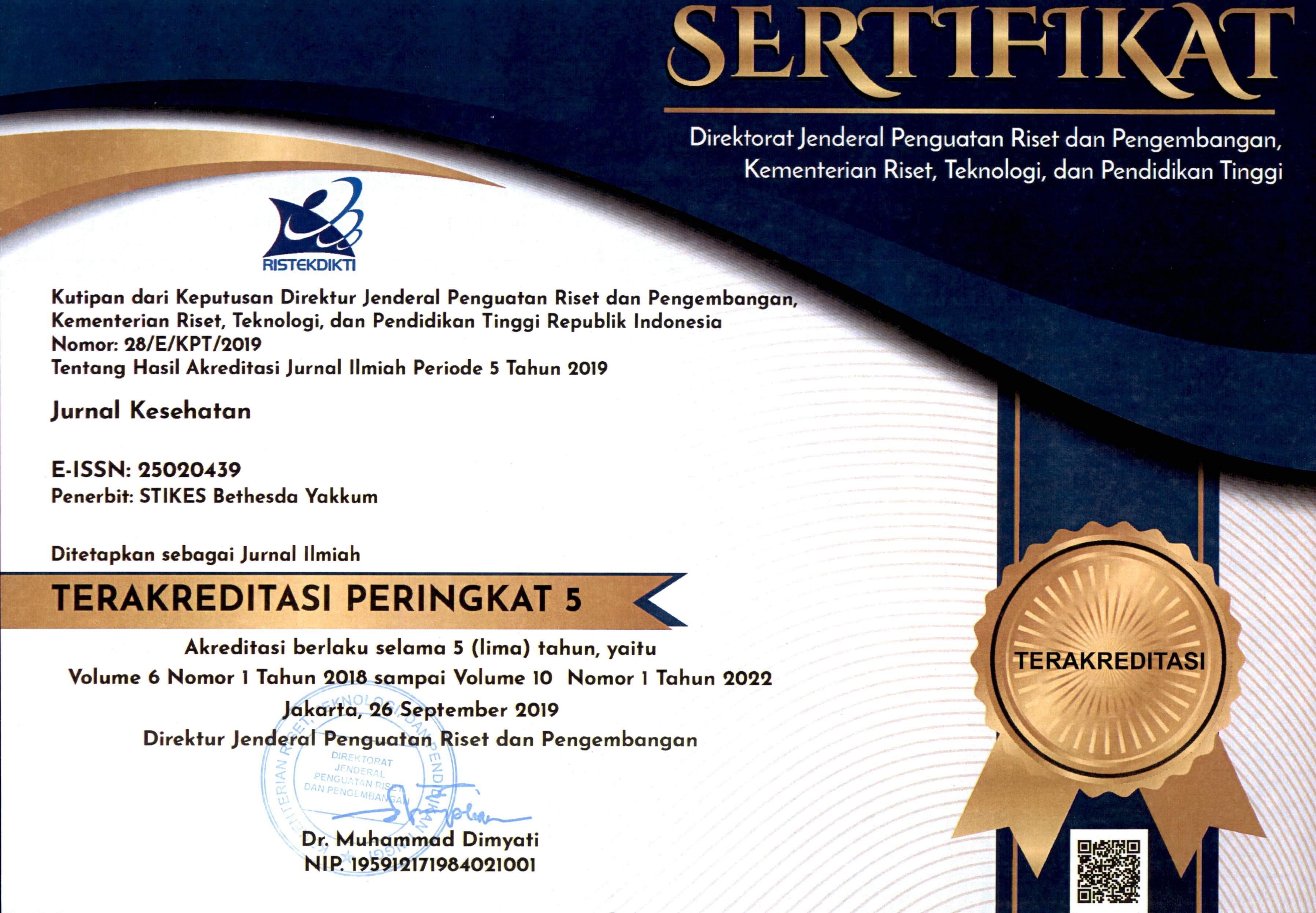HUBUNGAN PEKERJAAN IBU DAN PRAKTIK ASI EKSLUSIF DENGAN KEJADIAN STUNTING PADA BALITA DI KABUPATEN TIMOR TENGAH SELATAN
DOI:
https://doi.org/10.35913/jk.v8i2.200Keywords:
Pekerjaan; ASI Ekslusif; Stunting BalitaAbstract
The nutritional status of the community is a major reflection of the economic development and welfare of a country. One of the indicators to measure the progress of the Indonesian Healthy Program is the prevalence of stunting in children under five. East Nusa Tenggara Province, particularly Timor Tengah Selatan (TTS) District, is the only province and district in Indonesia that reports the highest incidence of stunting on a national scale. The purpose of this study was to determine the relationship between maternal occupation and exclusive breastfeeding practices with the incidence of stunting in children under five in TTS district. The design of this study was cross-sectional analytic. The population in this study were mothers and children aged 12-60 months in TTS Regency. The number of respondents in this study was 286 mothers and children. The sample was selected using purposive sampling technique. Data were collected using a questionnaire and anthropometric measurements (height and weight) according to WHO standards. The data collected were analyzed using bivariate analysis (chi square test). The results showed that 26.6% were stunted and 73.4% of children under five were not stunted, while 81.5% of mothers did not have a job and 68.2% of mothers did not exclusively breastfeed. The results of the Chi-Square test found that there was no significant relationship between maternal occupation and stunting with a p-value of 0.159 and there was a significant relationship between exclusive breastfeeding and the incidence of stunting with a p-value of 0.000.
References
Abuya, B. A., Ciera, J., & Kimani-Murage, E. (2012). Effect of mother’s education on child’s nutritional status in the slums of Nairobi. BMC Pediatrics, 12. https://doi.org/10.1186/1471-2431-12-80
Agustina, A., & Hamisah, I. (2019). Hubungan Pemberian Asi Ekslusif, Berat Bayi Lahir Dan Pola Asuh Dengan Kejadian Stunting Di Wilayah Kerja Puskesmas Reubee Kabupaten Pidie. Journal of Healthcare Technology and Medicine, 5(2), 162. https://doi.org/10.33143/jhtm.v5i2.397
Anisa, P., Gizi, P. S., Gizi, D., Masyarakat, K., Masyarakat, F. K., & Indonesia, U. (2012). Faktor - Faktor Yang Berhubungan Dengan Kejadian Stunting Pada Balita Usia 25 – 60 Bulan Di Kelurahan Kalibaru Tahun 2012.http://lib.ui.ac.id/file?file=digital/20320460-S-Paramitha Anisa.pdf
Damayanti, R. A., Muniroh, L., & Farapti, F. (2017). Perbedaan Tingkat Kecukupan Zat Gizi Dan Riwayat Pemberian Asi Eksklusif Pada Balita Stunting Dan Non Stunting. Media Gizi Indonesia, 11(1), 61. https://doi.org/10.20473/mgi.v11i1.61-69
Demissie, S. (2013). Magnitude and Factors Associated with Malnutrition in Children 6-59 Months of Age in Pastoral Community of Dollo Ado District, Somali Region, Ethiopia. Science Journal of Public Health, 1(4), 175. https://doi.org/10.11648/j.sjph.20130104.12
Fikrina, L. T., & Rokhanawati, D. (2017). Hubungan Tingkat Sosial Ekonomi Dengankejadian Stunting Pada Balita Usia 24-59 Bulan Di Desa Karangrejek Wonosarigunung Kidul. http://lib.unisayogya.ac.id
Fitri, L. (2018). Hubungan Bblr Dan Asi Ekslusif Dengan Kejadian Stunting Di Puskesmas Lima Puluh Pekanbaru. Jurnal Endurance, 3(1), 131.https://doi.org/10.22216/jen.v3i1.1767
Jamro, B., Junejo, A. A., Lal, S., Rasool Bouk, G., & Jamro, S. (2012). Risk Factors for Severe Acute Malnutrition in Children under the Age of Five Year in Sukkur. In Pakistan Journal of Medical Research (Vol. 51, Issue 4).www.unicef.org/sowc2012/english/index.html
Kamiya, Y. (2011). Socioeconomic determinants of nutritional status of children in Lao PDR: Effects of household and community factors. Journal of Health, Population and Nutrition, 29(4), 339–348. https://doi.org/10.3329/jhpn.v29i4.8449
Kemenkes. (2011). Keputusan Menteri Kesehatan RI tentang Standar Antropometri Penilaian Status Gizi Anak. In Standar Antropometri Penilaian Status Gizi Anak (p. 40). http://hukor.kemkes.go.id/uploads/produk_hukum/PMK_No__2_Th_2020_ttg_Standar_Antropometri_Anak.pdf
Kemenkes. (2018). Profil Dinas Kesehatan Kabupaten Timor Tengah Selatan tahun 2018. https://www.kemkes.go.id/resources/download/profil/PROFIL_KAB_KOTA_2018/5304_NTT_Kab_TTS_2018.pdf
Lestari, W., Margawati, A., & Rahfiludin, Z. (2014). Faktor risiko stunting pada anak umur 6-24 bulan di kecamatan Penanggalan kota Subulussalam provinsi Aceh. Jurnal Gizi Indonesia (The Indonesian Journal of Nutrition), 3(1), 37–45. https://doi.org/10.14710/jgi.3.1.126-134
Ngaisyah, R. D. (2015). Hubungan Sosial Ekonomi Dengan Kejadian Stunting pada Balita di Desa Kanigoro, Saptosari Gunung Kidul. Jurnal Medika Respati, 10(4), 65–70. http://medika.respati.ac.id/index.php/Medika/article/view/105
Okoh, M. (2013). Socio-Demographic Correlates of Overweight and Obesity among Women of Reproductive Age in Nigeria | African Journal of Reproductive Health. J Reprod Health 2013;, 17(Vol. 17 No. 4 (2013)), 66– 76.https://doi.org/https://www.ajol.info/index.php/ajrh/article/view/98376
Paudel, R., Pradhan, B., Wagle, R. R., Pahari, D. P., & Onta, S. R. (2012). Risk factors for stunting among children: A community based case control study in Nepal. Kathmandu University Medical Journal, 10(39), 18–24. https://doi.org/10.3126/kumj.v10i3.8012
Ramli, Agho, K. E., Inder, K. J., Bowe, S. J., Jacobs, J., & Dibley, M. J. (2009). Prevalence and risk factors for stunting and severe stunting among under-fives in North Maluku province of Indonesia. BMC Pediatrics, 9, 64. https://doi.org/10.1186/1471-2431-9-64
Sohardjo. (2002). Perencanaan Pangan dan Gizi. http://library.um.ac.id/free-contents/downloadpdf.php/buku/perencanaan-pangan-dan-gizi-suhardjo-2707.pdf
Sunguya, B. F., Zhu, S., Mpembeni, R., & Huang, J. (2019). Trends in prevalence and determinants of stunting in Tanzania: An analysis of Tanzania demographic health surveys (1991-2016). Nutrition Journal, 18(1), 85. https://doi.org/10.1186/s12937-019-0505-8
TNP2K. (2018). Strategi Nasional Percepatan Pencegahan Stunting 2018-2024. http://www.tnp2k.go.id/filemanager/files/Rakornis 2018/Sesi 1_01_RakorStuntingTNP2K_Stranas_22Nov2018.pdf
Torlesse, H., Cronin, A. A., Sebayang, S. K., & Nandy, R. (2016). Determinants of stunting in Indonesian children: Evidence from a cross-sectional survey indicate a prominent role for the water, sanitation and hygiene sector in stunting reduction. BMC Public Health, 16(1), 669. https://doi.org/10.1186/s12889-016-3339-8
UNICEF. (2019). Breastfeeding | UNICEF.https://www.unicef.org/topics/breastfeeding
Weise, A. S. (2010). Stunting Policy Brief. WHO Global Nutrition Target, 9. https://www.who.int/nutrition/topics/globaltargets_stunting_policybrief.pdf
Welasasih, B. D., Bambang, D. R., Departemen, W., Fakultas, G. K., Masyarakat, K., Airlangga, U., Korespondensi, A., Bambang, : R, & Kesehatan, G. (2012). Beberapa Faktor yang Berhubungan dengan Status Gizi Balita Stunting. Departemen Gizi Kesehatan, 8, 99–104.http://www.journal.unair.ac.id/filerPDF/2. Beberapa Faktor yang Berhubungan dengan.pdf
Yang, W., Li, X., Li, Y., Zhang, S., Liu, L., Wang, X., & Li, W. (2012). Anemia, malnutrition and their correlations with socio-demographic characteristics and feeding practices among infants aged 0-18 months in rural areas of Shaanxi province in northwestern China: A cross-sectional study. BMC Public Health, 12(1). https://doi.org/10.1186/1471-2458-12-1127









